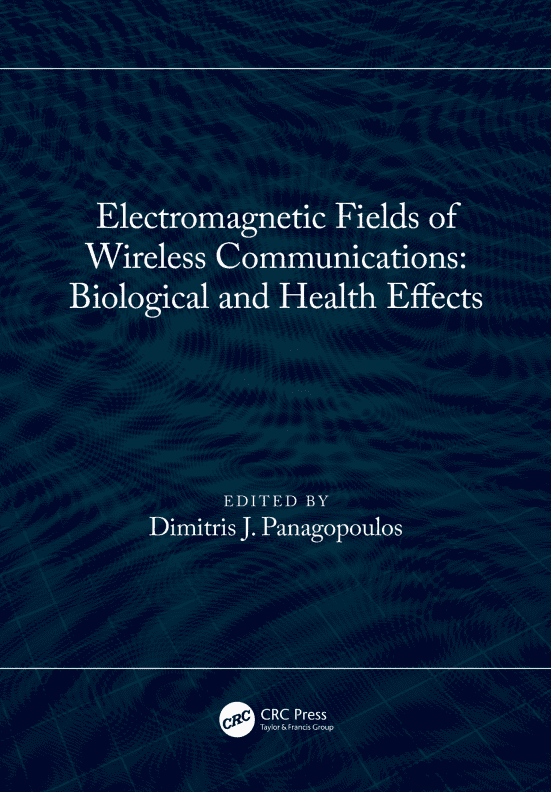Heart Coherence
Heart Health and Electromagnetic Fields: Understanding the Impact and the Role of SPIRO® Technology
Exposure to non-native electromagnetic fields (EMFs) can potentially affect heart rhythm in various ways. Some studies suggest that EMF exposure may influence cardiac function through several mechanisms:
Firstly, it can reduce Heart Rate Variability (HRV), which is associated with an increased risk of cardiac events and a decreased ability of the body to adapt to stress. HRV is an indicator of the autonomic nervous system’s ability to regulate heart rate in response to different stimuli. EMF exposure may also impact the heart’s electrophysiological activity, induce oxidative stress that damages myocardial cells, and alter the heart’s electrical conduction. This can lead to abnormalities in heart rhythm, manifesting as tachycardia (rapid heartbeats), bradycardia (slow heartbeats), or ventricular and supraventricular arrhythmias.
Additionally, some studies indicate that EMF exposure might be linked to increased blood pressure, placing additional strain on the heart and potentially contributing to conditions such as left ventricular hypertrophy and long-term heart failure. Individuals with preexisting heart conditions, such as heart failure or ischemic heart disease, may be more susceptible to the adverse effects of EMF exposure. These individuals might experience exacerbations of their symptoms or an increased risk of acute cardiac events.
The use of SPIRO® filtering technology can offer several potential benefits for mitigating heart-related issues associated with EMF exposure. Designed to filter these emissions, SPIRO® technology may help maintain or even improve HRV. A healthy HRV is crucial for optimal cardiovascular function and better stress response, which in turn helps reduce oxidative stress in myocardial cells, minimizing cellular damage and enhancing heart health.


SPIRO® helps balance autonomic nervous system activity, contributing to the stability of cardiac cell depolarization and repolarization, thereby reducing the incidence of both ventricular and supraventricular arrhythmias. Quality sleep is directly related to heart health, and EMF exposure can negatively affect sleep quality, impacting heart health. By filtering EMFs, SPIRO® can improve sleep quality, directly benefiting cardiovascular health by promoting adequate recovery and regeneration during nightly rest.
Although SPIRO® technology is relatively new and more specific research is needed to fully understand its cardiovascular benefits, the underlying principles of reducing EMF exposure suggest that this technology could play a significant role in preventing and managing heart issues related to EMF exposure. The potential benefits mentioned align with observed effects on reducing EMF exposure and improving overall heart health.
If you are considering implementing SPIRO® technology to protect yourself from the negative effects of EMFs on heart health, it is recommended to consult with a cardiology specialist for personalized advice and to ensure that appropriate measures are taken for your specific situation.
For further questions or detailed information on SPIRO® technology and its benefits, feel free to ask.
Suggested SPIRO® Protocol
- Spiro Card: Carry it permanently on your cellphone.
- Square X: Wear it permanently at chest level.
- Spiro Disc: Install it permanently on your home or office Wi-Fi router.

Studies and Scientific References
While there is a growing body of research suggesting these effects, it is important to note that the evidence is not yet conclusive, and further studies are needed to fully understand the relationship between EMF exposure and cardiovascular health.
Key studies include:
Electromagnetic fields, cardiac function and human health
By Bortkiewicz et al., 2020, which discusses the potential effects of EMF exposure on cardiac function and human health.
Heart rate variability changes associated with exposure to electromagnetic fields
By Havas et al., 2010, which examines how EMF exposure can alter heart rate variability and the associated cardiac risk.
Biophysical testing of the SPIRO CARD LEVEL 2 regarding the protective effect with electromagnetic radiation
Learn about the latest evaluation by the International Association for Electromagnetic pollution Research (IGEF), which tested the SPIRO L4’s effectiveness in mitigating the health effects of high-frequency electromagnetic fields. This study, involving individuals with electrohypersensitivity, found significant improvements in heart rate variability. Access the full report to explore the detailed findings and implications.
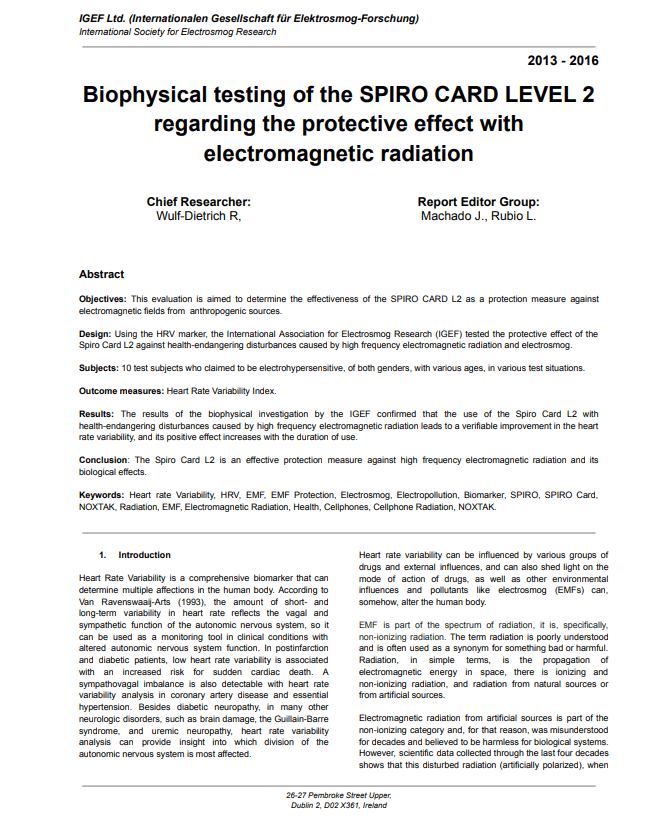
Biophysical testing of the SPIRO LEVEL 5 regarding the protective effect with electromagnetic radiation
Learn about the latest evaluation by the International Association for Electromagnetic pollution Research (IGEF), which tested the SPIRO L4’s effectiveness in mitigating the health effects of high-frequency electromagnetic fields. This study, involving individuals with electrohypersensitivity, found significant improvements in heart rate variability. Access the full report to explore the detailed findings and implications.
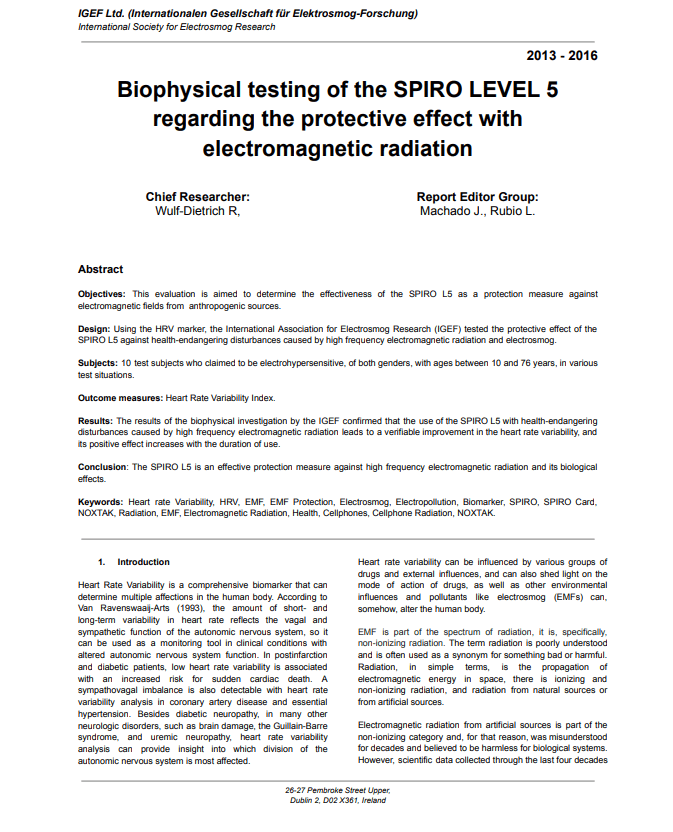
Influence of electromagnetic protection technology on human psychophysiological condition
Learn about the latest evaluation by the International Association for Electromagnetic pollution Research (IGEF), which tested the SPIRO L4’s effectiveness in mitigating the health effects of high-frequency electromagnetic fields. This study, involving individuals with electrohypersensitivity, found significant improvements in heart rate variability. Access the full report to explore the detailed findings and implications.
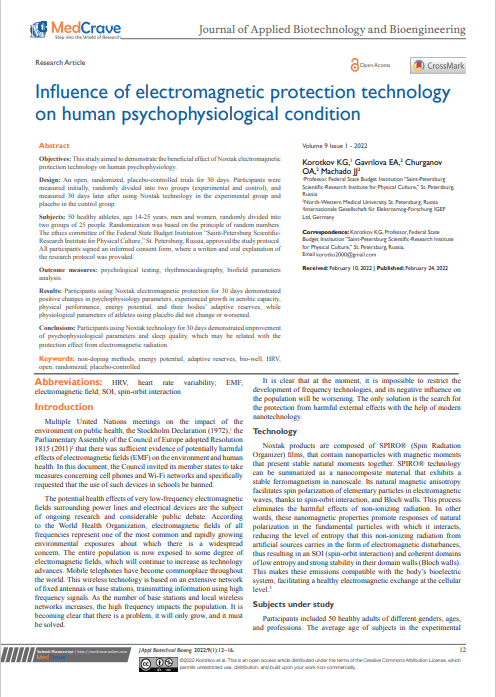
Electromagnetic Fields - Do They Pose a Cardiovascular Risk
Learn about the latest evaluation by the International Association for Electromagnetic pollution Research (IGEF), which tested the SPIRO L4’s effectiveness in mitigating the health effects of high-frequency electromagnetic fields. This study, involving individuals with electrohypersensitivity, found significant improvements in heart rate variability. Access the full report to explore the detailed findings and implications.
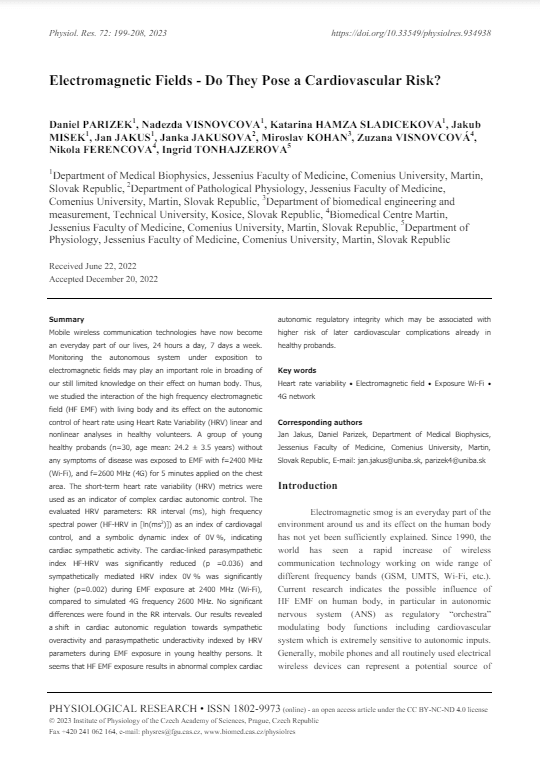
Electromagnetic Fields of Wireless Communications: Biological and Health Effects
Learn about the latest evaluation by the International Association for Electromagnetic pollution Research (IGEF), which tested the SPIRO L4’s effectiveness in mitigating the health effects of high-frequency electromagnetic fields. This study, involving individuals with electrohypersensitivity, found significant improvements in heart rate variability. Access the full report to explore the detailed findings and implications.
